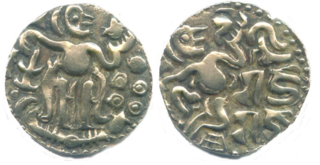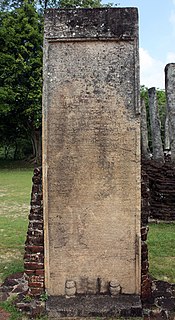Related Research Articles

The Principality of Ruhuna, also referred to as the Kingdom of Ruhuna, is a region of present-day Southern and Eastern Sri Lanka. It was the center of a flourishing civilisation and the cultural and economic centres of ancient Sri Lanka. Magama, Tissamaharama and Mahanagakula were established here.

Rajaraja I born Arulmoli Varman often described as Rajaraja the Great was a Chola emperor who reigned from 985 CE to 1014 CE and was the most powerful king in south at his time chiefly remembered for reinstating the Chola power and ensuring its supremacy in South India and Indian Ocean.

Rajadhiraja I was a Chola emperor and the successor of his father, Rajendra I. During his short reign, he helped his father conquer several territories and maintained the Chola authority over most of Sri Lanka, Eastern Chalukya, Kalinga, among others and also the relations with overseas domains despite a series of revolts in the territory. Rajadhiraja Chola proved capable of maintaining the vast and expansive empire with territories even outside the shores of India. Records also show that the king was a skilled commander on the battlefield, leading his soldiers from the front lines. He earned the title Jayamkonda Chola after numerous victories. Towards the end of his reign, he sacked the Western Chalukyan capital Kalyanapuram and assumed the title Kalyanapuramgonda Chola and performed a Virabhisheka under the name Vijaya Rajendra Cholan.

Parantaka Chola I was a Chola emperor who ruled for forty-eight years, annexing Pandya by defeating Rajasimhan II. The best part of his reign was marked by increasing success and prosperity.

Queen Lilavati was the fourth woman in Sri Lankan history to rule as sovereign in her own right. Lilavati rose to prominence as the wife of Parakramabahu I, king of the Kingdom of Polonnaruwa. Being of royal descent herself, she then ruled as sole monarch on three occasions in the near-anarchy following Parakramabahu's death, with the backing of various generals. The primary source for her life is the Culavamsa, specifically chapter LXXX.

The Later Chola dynasty ruled the Chola Empire from 1070 C.E. until the demise of the empire in 1279 C. E. This dynasty was the product of decades of alliances based on marriages between the Cholas and the Eastern Chalukyas based in Vengi, and produced some of the greatest Chola emperors such as Kulothunga Chola I. Even though the later Cholas are often referred to as Chalukya Cholas, there were two breaks in the line. Kulothunga Chola II and Rajadhiraja Chola II did not belong to the Chalukya Chola line. Kulottunga II was a grandson of Vikrama Chola and Rajadhiraja Chola II was not the son of Rajaraja Chola II.

Parākramabāhu I, or Parakramabahu the Great, was the king of the Kingdom of Polonnaruwa from 1153 to 1186. He oversaw the expansion and beautification of his capital, constructed extensive irrigation systems, reorganised the country's army, reformed Buddhist practices, encouraged the arts and undertook military campaigns in South India and Burma. The adage "Not even a little water that comes from the rain must flow into the ocean without being made useful to man" is one of his most famous utterances.

the Kingdom of Polonnaruwa was the kingdom that ruled the island of Sri Lanka and several overseas territories, from 1070 until 1232. The kingdom started expanding its overseas authority during the reign of Parakramabahu the Great.
Vikramabahu was a medieval king of Sri Lanka. Following the death of his father in 1029, Vikramabahu led the resistance movement against the Chola invaders of the country, ruling from the southern principality of Ruhuna. He spent a number of years building up his forces to drive out the Chola, but died before he could launch his military campaign.
Kitti Sri Megha, also referred to as Kittisrimegha, was a medieval king of the principality of Dakkinadesa in Sri Lanka. The nephew of King Vijayabahu I, he attempted to seize the throne of Sri Lanka along with his two brothers in 1110 CE, but was defeated by Vickramabahu I. He then retreated to the south of the country, which he initially ruled with his younger brother Sri Vallabha. He later ascended to the throne of Dakkinadesa following the death of his older brother Manabharana.

Vijayabahu I, also known as Vijayabahu the Great, was a medieval king of Sri Lanka. Born to a royal bloodline, Vijayabahu grew up under Chola occupation. He assumed rulership of the Ruhuna principality in the southern parts of the country in 1055. Following a seventeen-year-long campaign, he successfully drove the Cholas out of the island in 1070, reuniting the country for the first time in over a century. During his reign, he re-established Buddhism in Sri Lanka and repaired much of the damage caused to infrastructure during the wars. He offered the Thihoshin Pagoda(Lord of Sri Lanka Buddha image) to Burma king Alaungsithu and it is now still in Pakokku.

The Chola conquest and occupation of Anuradhapura Kingdom was a military invasion of the Kingdom of Anuradhapura by the Chola Empire. It initially began with the invasion of the Anuradhapura Kingdom in 993 AD by Rajaraja I when he sent a large Chola army to conquer the kingdom and absorb it into the Chola Empire. Most of the island was subsequently conquered by 1017 and incorporated as a province of the vast Chola empire during the reign of his son Rajendra Chola I. The Chola occupation would be overthrown in 1070 through a campaign of Sinhalese Resistance led by Prince Kitti, a Sinhalese royal. The Cholas fought many subsequent wars and attempted to reconquer the Sinhalese kingdom as the Sinhalese were allies of their arch-enemies, the Pandyas. The period of Chola entrenchment in northern Sri Lanka lasted in total about three-quarters of a century, from roughly 993 to 1070, when Vijayabahu I recaptured the north and expelled the Chola forces restoring Sinhalese sovereignty.

Seruwawila Mangala Raja Maha Vihara is an ancient Buddhist temple in Trincomalee district in Eastern Province, which is among the sixteen or seventeen holiest Buddhist shrines (Solosmasthana) in Sri Lanka.
Ilanaga also known as Elunna, was King of Anuradhapura in the 1st century, whose reign lasted from 38 to 44. He overthrew and succeeded his aunt Sivali as King of Anuradhapura and was succeeded by his son Chandamukha.
Aggabodhi III was King of Anuradhapura in the 7th century, whose reign lasted the year 623 and from 624 to 640. He succeeded his father Silameghavanna as King of Anuradhapura.
Mahinda I was King of Anuradhapura in the 8th century, whose reign lasted from 738 to 741. He succeeded his brother Kassapa III as King of Anuradhapura and was succeeded by his nephew Aggabodhi VI.
Aggabodhi VII was King of Anuradhapura in the 8th century, whose reign lasted from 781 to 787. He succeeded his cousin Aggabodhi VI as King of Anuradhapura and was succeeded by Mahinda II.His father was King Mahinda I.
Mahinda II was King of Anuradhapura in the 9th century, whose reign lasted from 787 to 807. He succeeded Aggabodhi VII as King of Anuradhapura and was succeeded by his son Dappula II. His father was King Aggabodhi VI.

The Polonnaruwa period was a period in the history of Sri Lanka from 1017, after the Chola conquest of Anuradhapura and when the center of administration was moved to Polonnaruwa, to the end of the Kingdom of Polonnaruwa in 1232.
Vikrama Pandu was a son of king Mahalana-Kitti who reigned in Kalutara in Maya Rata during the Chola conquest of Anuradhapura. He was able to rule Maya Rata only for a year until he was overthrown by Jagathpala, a prince from Ayodhyapura.
References
- Nishantha Joseph, Sujeewa. Sinhalese Kings (in Sinhala). Jayasinghe Book Publishers. ISBN 9789550642328.